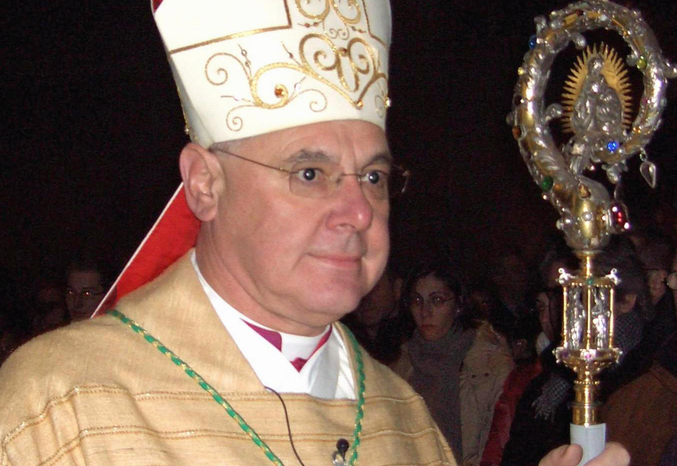A Heretic Leads the Vatican’s Office of “Orthodoxy”:
A Prefect for the Destruction of the Faith: “Archbishop” Gerhard Ludwig Müller Denies the Dogma of Transubstantiation in 2002 Book on the Mass

The CDF’s Archheretic Gerhard L. Muller
In his 2002 book Die Messe: Quelle Christlichen Lebens (“The Mass: Source of Christian Life”), the head of the Vatican’s so-called Congregation for the Doctrine of the Faith, “Archbishop” Gerhard Ludwig Muller, appointed to the post by “Pope” Benedict XVI, denies the Catholic dogma of Transubstantiation, defined by the Council of Trent. The Semi-Traditionalist site Tradition In Action provides the evidence. See here:
Against Muller’s heresy, the Council of Trent defined infallibly:
If any one denieth, that, in the sacrament of the most holy Eucharist, are contained truly, really, and substantially, the body and blood together with the soul and divinity of our Lord Jesus Christ, and consequently the whole Christ; but saith that He is only therein as in a sign, or in figure, or virtue; let him be anathema.
If any one saith, that, in the sacred and holy sacrament of the Eucharist, the substance of the bread and wine remains conjointly with the body and blood of our Lord Jesus Christ, and denieth that wonderful and singular conversion of the whole substance of the bread into the Body, and of the whole substance of the wine into the Blood-the species Only of the bread and wine remaining-which conversion indeed the Catholic Church most aptly calls Transubstantiation; let him be anathema.
If any one denieth, that, in the venerable sacrament of the Eucharist, the whole Christ is contained under each species, and under every part of each species, when separated; let him be anathema.
If any one saith, that, after the consecration is completed, the body and blood of our Lord Jesus Christ are not in the admirable sacrament of the Eucharist, but (are there) only during the use, whilst it is being taken, and not either before or after; and that, in the hosts, or consecrated particles, which are reserved or which remain after communion, the true Body of the Lord remaineth not; let him be anathema.
(Council of Trent, Session 13, Canons on the Most Holy Sacrament of the Eucharist, nn. 1-4)
Do not let yourself be hoodwinked if someone points out that Muller has acknowledged the dogma of Transubstantiation elsewhere. This is an old trick, once exposed and condemned by Pope Pius VI:
“[The Ancient Doctors] knew the capacity of innovators in the art of deception. In order not to shock the ears of Catholics, they sought to hide the subtleties of their tortuous maneuvers by the use of seemingly innocuous words such as would allow them to insinuate error into souls in the most gentle manner. Once the truth had been compromised, they could, by means of slight changes or additions in phraseology, distort the confession of the faith which is necessary for our salvation, and lead the faithful by subtle errors to their eternal damnation. This manner of dissimulating and lying is vicious, regardless of the circumstances under which it is used. For very good reasons it can never be tolerated in a synod of which the principal glory consists above all in teaching the truth with clarity and excluding all danger of error.
“Morever, if all this is sinful, it cannot be excused in the way that one sees it being done, under the erroneous pretext that the seemingly shocking affirmations in one place are further developed along orthodox lines in other places, and even in yet other places corrected; as if allowing for the possibility of either affirming or denying the statement, or of leaving it up the personal inclinations of the individual – such has always been the fraudulent and daring method used by innovators to establish error. It allows for both the possibility of promoting error and of excusing it.
“It is as if the innovators pretended that they always intended to present the alternative passages, especially to those of simple faith who eventually come to know only some part of the conclusions of such discussions which are published in the common language for everyone’s use. Or again, as if the same faithful had the ability on examining such documents to judge such matters for themselves without getting confused and avoiding all risk of error. It is a most reprehensible technique for the insinuation of doctrinal errors and one condemned long ago by our predecessor Saint Celestine who found it used in the writings of Nestorius, Bishop of Constantinople, and which he exposed in order to condemn it with the greatest possible severity. Once these texts were examined carefully, the impostor was exposed and confounded, for he expressed himself in a plethora of words, mixing true things with others that were obscure; mixing at times one with the other in such a way that he was also able to confess those things which were denied while at the same time possessing a basis for denying those very sentences which he confessed.
“In order to expose such snares, something which becomes necessary with a certain frequency in every century, no other method is required than the following: Whenever it becomes necessary to expose statements which disguise some suspected error or danger under the veil of ambiguity, one must denounce the perverse meaning under which the error opposed to Catholic truth is camouflaged.”
(Pope Pius VI, Apostolic Constitution Auctorem Fidei, 1794)
So, the Vatican once again has a heretic overseeing “orthodoxy” the world over.
Congratulations.
Image source: Wikimedia Commons (cropped)
Licenses: CC BY-SA 3.0 (Dr. Meierhofer)



No Comments
Be the first to start a conversation